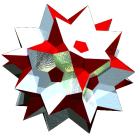|
Acronym
|
...
|
|
Name
|
Rectified Hessian polyhedron,
complex polyhedron x3-3-o3-4-o2
|
|
Circumradius
|
1
|
|
Vertex figure
|
x3-4-o2
|
|
Coordinates
|
-
(ε3n, ε3m, ε3k)/sqrt(3) & for any 1≤n,m,k≤3
-
(-ε3n, -ε3m, -ε3k)/sqrt(3) & for any 1≤n,m,k≤3
-
(ε3n, 0, 0) & for any 1≤n≤3, all permutations, all changes of sign
where: ε3=exp(2πi/3)=(-1+i sqrt(3))/2
|
|
Dual
|
x2-4-o3-3-o3
|
|
Face vector
|
72, 216, 54
|
|
Confer
|
- real space embedding:
-
mo
- general polytopal classes:
-
complex polytopes
|
External
links
|


|
When considered as a regular complex polyhedron, one derives its below provided incidence structure as follows.
The vertex count is readily obtained either by its real space embedding (mo) or by the count of the
above provided explicite coordinates (27+27+18).
The in here to be used (complex) faces are x3-3-o3,
which in turn were substructures of hex.
Further the (complex) vertex figure here is x3-4-o2,
thence the super-diagonal entries of the matrix are clear as well.
When considered as a rectified complex polyhedron, one derives its incidence structure as follows.
That afore mentioned vertex figure could be viewed alternatively as
x3-2-x3 instead, which then applies in here.
Further one notes, that the pre-image for this rectification is just
x3-3-o3-3-o3.
And because the rectification uses its vertices at the centers of the formers edges (up to some global scaling),
it becomes clear that the new vertex number is the formers edge number.
Finally one notes, that the faces of a rectified polyhedron consist out of the duals of the former's faces plus the former's vertex figures.
Accordingly, the face number of the rectified polyhedron equals the sum of the former's face number plus the former's vertex number.
Taking this all together on derives the incidence matrix of the second, rectified representation independently from the first,
regular representation, i.e. directly from its non-rectified base.
Incidence matrix according to Dynkin symbol
x3-3-o3-4-o2
. . . | 72 ♦ 9 | 6
-------------+----+-----+---
x3 . . | 3 | 216 | 2
-------------+----+-----+---
x3-3-o3 . ♦ 8 | 8 | 54
o3-3-x3-3-o3
. . . | 72 ♦ 9 | 3 3
-------------+----+-----+------
. x3 . | 3 | 216 | 1 1
-------------+----+-----+------
o3-3-x3 . ♦ 8 | 8 | 27 *
. x3-3-o3 ♦ 8 | 8 | * 27

